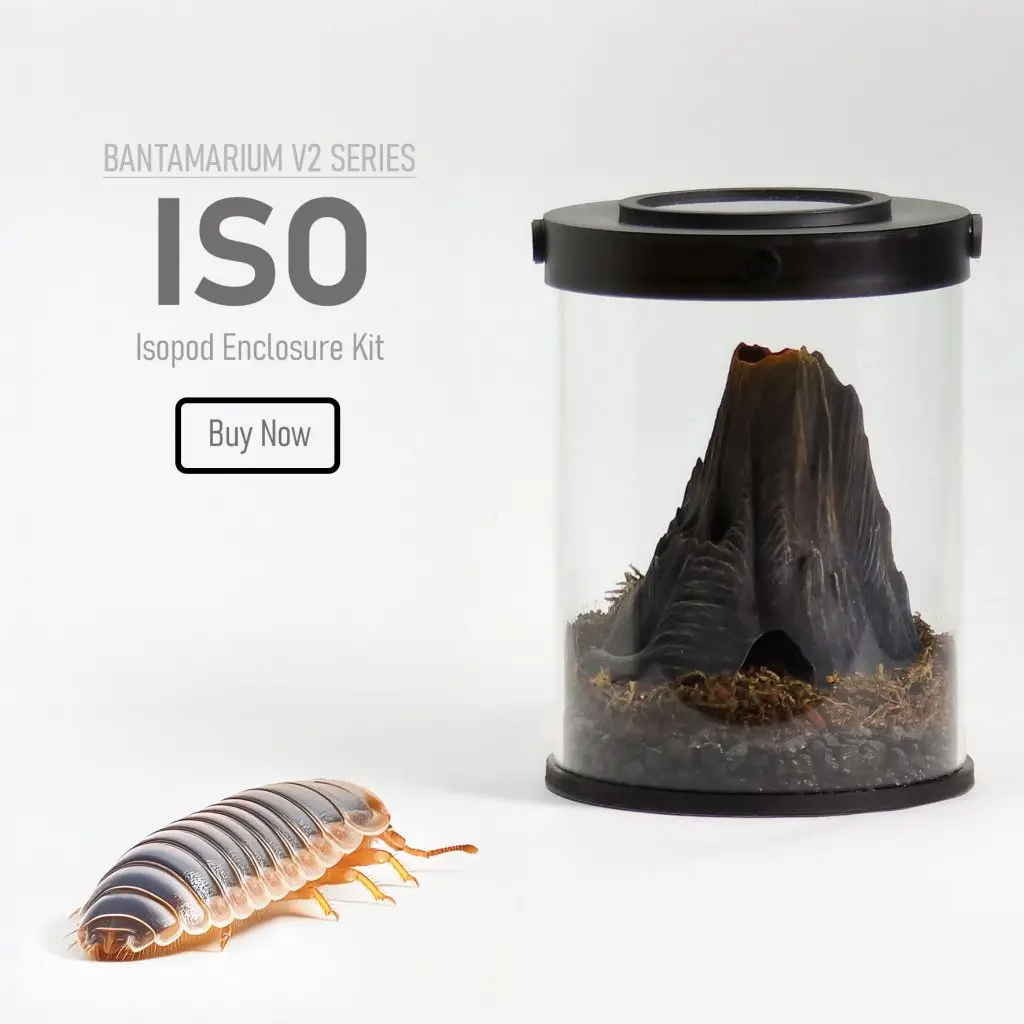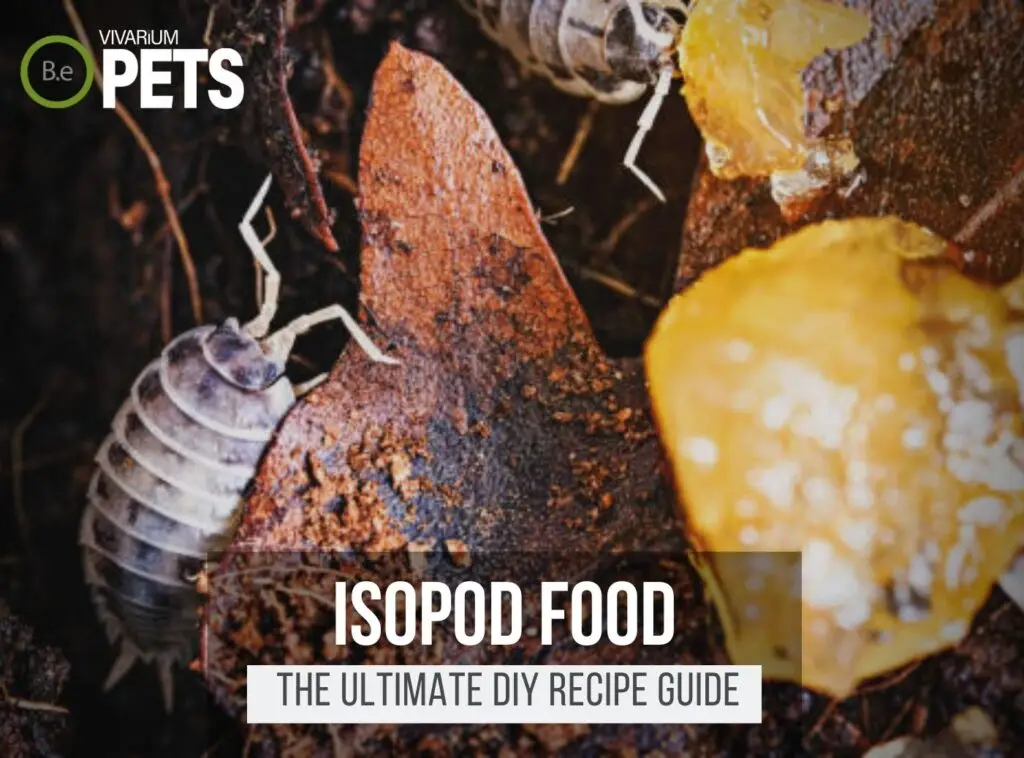Are you looking for an unusual pink pet to liven up your life? If so, Pink Cubaris murina, commonly known as Papaya Isopods could be the perfect choice for you!
These small, friendly creatures from North America are becoming instantly popular as exotic pets.
In this article, we’ll explore the essentials of papaya isopod care including proper environmental setup, diet, and more.
Read on to learn how to best care for these fascinating little cubaris isopods and ensure they live a long healthy life.
| Characteristics: | |
|---|---|
| Common Name | Papaya Isopods, Pink Isopods, Pink Ducky |
| Family Name | Armadillidae |
| Scientific Name | Cubaris murina 'Papaya' |
| Use | Cleaning, Aerating Soil, Feeders |
| Temperament | Non-aggressive |
| Lifespan | 1-2 Years |
| Diet | Detritivore |
| Adult Size | 2 cm |
| Breeding Type | Egg Layer |
| Care Level | Easy |
| Minimum Tank Size | 2-5 Gallons |
| pH | 5.5-8.0 |
| Hardness | Soft |
| Temperature | 72-77°F |
Table Of Contents:
ToggleWhat Are Papaya Isopods?
Papaya Isopods are small, tropical isopods most commonly found in the US. They get their scientific name from the order they belong to – Isopoda – and their common name from their distinctive pink coloration.
They are sometimes known as Pink Isopods, Pink Ducky Isopods, and of course, Papaya Isopods. That last common name comes from their similarity to the outside skin of the papaya fruit.
Although not edible, these isopods are popular as exotic pets and will happily eat leafy greens, vegetable matter, and fruits like bananas.
Papaya isopods are hardy creatures and can live for about two to three years if cared for properly.
Create an ideal habitat for your Papaya Isopods with our Customizable Isopod Terrarium Kits, which include everything you need to get started.
What Do Papaya Isopods Look Like?
Papaya isopods are small, pinkish-brown crustaceans that are mutations of the grey “Little Sea Isopods.”
They grow to an adult size of approximately one inch in length. The body has 7 segments, 7 pairs of legs, and two antennae.
The body color is pinkish-brown and the legs can be a pale yellow-orange color.
Other than the typical crustacean adaptations for burrowing and swimming, one of the most striking features of papaya isopods is their vibrant pink hue.
This hue is due to the combination of the close-set eyes and the eye-catching red carapace.
Papaya isopods are also known as “Pink Isopods”, due to their bright pink tint. This unique coloration is unique to these creatures, and no other species of isopod has it.
As a result, these tropical isopods are one of the most popular exotic pets in the United States, particularly among those who enjoy tending to unusual creatures.
Benefits Of Using Papaya Isopods
Papaya isopods are an excellent addition to any vivarium setup due to their eye-catching color and active behavior.
They are great for aiding in tank clean-up as they eat leftover food, decaying organic matter, and any other detritus. They are generally great at keeping your environment free of these pollutants.
They are also low-maintenance and easy to care for, with their simple dietary needs. Papaya isopods are beneficial to the interplay of terrarium ecosystems.
They are natural aerators, loosening and aerating the terrarium substrate so other inhabitants can benefit from oxygenation.
They also generate a more organic look as they burrow and form caves in the soil. Furthermore, they also provide entertainment and intrigue as they are active, and fascinating to observe in the tanks.

Papaya Isopods Facts
Papaya isopods (Cubaris murina) are small invertebrate pets with a pinkish-brown coloration and a moderate temperament.
They prefer temperatures of 70-75°F (21-24°C) and a diet including leaves, fruit, and other small decaying invertebrates.
Breeding papaya isopods in captivity can be challenging, as they require specific conditions and perfect moderation of the enclosure’s humidity and temperature.
Habitat
When it comes to their environment, Papaya Isopods prefer cooler temperatures, ranging between 60-75°F. As they’re sensitive to dry environments, they like humid spots and need a moisture-rich substrate.
They also rely on frequent misting to ensure their survival and will die if exposed to dry temperatures higher than 85°F.
Replicate their natural habitat perfectly with our Bioactive Isopod Substrate Blend, designed to provide the ideal moisture and organic content for your isopods.
Diet
In the wild, papaya isopods eat decaying vegetation, such as decaying fruit, leaves, and wood, as well as bacteria and fungi.
They may also feed on soft-bodied insects, such as fruit flies and pinhead crickets.
Temperament
Papaya isopods are quite harmless and calm. They do not bite humans or other animals, making them ideal as exotic pets for all kinds of households.
If you handle your isopods correctly and with care, you will find that these small creatures can quickly become tame and almost bomb-proof.
Isopods are generally nocturnal, preferring to be active during the night, and providing constant entertainment.
During the day, they are often found lurking in their burrows and under the substrate, so they don’t cause a nuisance. Papaya isopods are docile enough so that they can be kept and enjoyed by children in the family.
Lifespan
Papaya Isopods typically live up to a year on average and spend most of their life as adults.
As for their life cycle, it begins with the egg being laid, then hatching into an immature isopod which goes through 4 instars, ultimately transforming from a salmon-pink juvenile to a dark-red adult.
During the first 3 instars, their exoskeletons will molt multiple times waiting for the last instar to reach maturity.
During its lifespan, feeding, molting, and reproduction are the primary activities of an adult Papaya Isopod.
Breeding
Papaya isopods reproduce by forming a ‘mating wheel’ which is an interesting collection of isopods in a circle or wheeled formation.
During reproduction, the pair of isopods will attach to each other’s pleopods (reproductive organs). After mating has occurred, the female papaya isopod will shed its shells and eggs, which will be fertilized by the male’s sperm.
For the eggs to develop, they need to be kept in moist and humid conditions.
After hatching, the new papaya isopods are on their own, having to fend for themselves right away. These insect pets grow slowly, and it takes them 3 to 4 molts (the process of shedding their hard outer shell) before they reach adulthood.
At this point, the papaya isopods are sexually mature and ready to start reproducing themselves. The adult female papaya isopod can lay up to 40 eggs every 3-4 weeks.
It’s important to ensure that you have ample space for your isopods to spread out and not overcrowd.
Where To Find Papaya Isopods
Papaya isopods can be bought from reputable pet stores and breeders, as well as online. However, it is important to buy them from a trustworthy source to ensure the animals are healthy and ethically sourced.
It is also possible to find them in their natural habitat, in sandy and moist areas in the USA. They prefer this kind of environment, which should be mimicked in their home as closely as possible.
Before bringing papaya isopods home, it is essential to quarantine them to ensure they are not carrying any parasites or other types of diseases.
Papaya Isopods Care
The key to successfully caring for Papaya Isopods is providing suitable habitat, a healthy diet, and proper handling and transport.
Provide a varied diet of fruits, dried insects, and supplements. Make sure to handle them carefully and transport them in an appropriate container.
Tank Requirements
An ideal tank setup for papaya isopods should contain a substrate, preferably coconut fiber, kept at a depth of 2-3 inches (5-5.5 cm).
Vivarium type and size should depend on the number of isopods you have; generally, a larger terrarium will ensure they have plenty of room to explore.
The ideal pH should be between 7.5 and 8.0, the hardness should be between 5 and 10 dGH. The temperature should range between 75-85 F (20-30 C).
Isopods like shade, so the tank should receive an adequate, but not an excessive amount of terrarium light. The substrate should be regularly misted with reverse osmosis (RO) water and cleaned when necessary.
What Do Papaya Isopods Eat?
Feeding your papaya isopods is easy and there are several foods that they enjoy eating. They are naturally detritivorous, which means they will eat both plants and animals. Here is a list of some of the best food for your papaya isopods:
- Algae-based foods, such as spirulina and kelp
- Collard greens, spinach, and other leafy, green vegetables
- Fruits such as apples, bananas, and, of course, papayas
- Crickets and other small decaying insects
- Fish flakes or pellets
If you’re more of an avid hobbyist like myself, be sure to check out my ultimate DIY Isopod food guide. I give a more in-depth explanation of the best foods and my favorite recipe.
Best Tankmates For Papaya Isopods
When it comes to tank mates for papaya isopods, it’s important to find other creatures that are compatible with them and their environment.
The best tank mates for papaya isopods are those that are not carnivorous, as well as those that won’t compete for food or even try to prey upon the harmless isopods.
Examples include springtails, small and peaceful tropical fish, and other non-insect invertebrates such as snails and slugs.
It’s also important to ensure that all tank mates have similar temperature and water chemistry requirements. This means that other invertebrates or fish should not come from another region or have different environmental conditions which could lead to death or distress among the isopods.
Conclusion
Papaya isopods offer an exciting pet-keeping experience that the whole family can enjoy. With the right approach and by utilizing the tips and tricks explained here, you can ensure your isopods stay healthy and thrive in their environment.
With the right care, papaya isopods can be a great addition to your home for years to come. Whether you’re an experienced critter keeper or a beginner, these isopods are a great choice for you.
Create the ideal habitat for your isopods with our species-specific soil mixes and Insect Enclosure Kits. These products provide everything you need for a successful and thriving isopod colony.
Frequently Asked Questions
In general, adult Cubaris murina ‘Papaya‘ can reach up to 2cm in body length (excluding the tail).
The common names for pink Cubaris murina are Papaya Isopods, Pink Isopods, and Pink Ducky.
Yes, there are pink isopods. Cubaris murina ‘Papaya‘ is a type of terrestrial isopod. They are a pink-palish color and inhabit tropical and subtropical areas.





